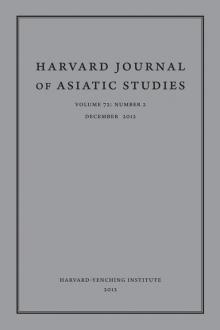December 2012
Articles
“My Tomb Will Be Opened in Eight Hundred Years”
A New Way of Seeing the Afterlife in Six Dynasties China
Jie Shi analyzes the sixth-century epitaph of Prince Shedi Huiluo as both a funerary text and a burial object in order to show that the means of achieving posthumous immortality radically changed during the Six Dynasties. Whereas the Han-dynasty vision of an immortal afterlife counted mainly on the imperishability of the tomb itself, Shedi’s epitaph predicted that the tomb housing it would eventually be ruined. This new, pessimistic vision of tombs was shaped by the experience people had in the Six Dynasties of encountering numerous ruined tombs in their daily life. To secure an afterlife for the deceased, they adopted a new strategy, which relied on words: they inscribed epitaphs on stone, concealed them in the tombs, and expected that after the tombs fell into ruin the epitaphs would resurface to be read by future audiences.
The Ethics of Immutable Things
Interpreting Lü Dalin’s Illustrated Investigations of Antiquity
Jeffrey Moser offers a new interpretation of Lü Dalin’s Kaogutu, the earliest extant illustrated catalog of Chinese antiquities. Earlier scholarship either incorporated the text into teleological histories of archaeology and epigraphy or conflated its agenda with that of other “antiquarian” writings. Moser argues instead that the catalog was integral to the distinctive philosophical agenda of its author, who envisioned the Kaogutu as both an argument for and a means of non- cognitive, sensory-driven moral cultivation. As such, the catalog evinces a key distinction between the moral philosophy of Lü Dalin and the cognitive ethics of his teacher Cheng Yi. By elucidating the connections between the Kaogutu and Lü Dalin’s sensory ethics, Moser explains how Lü transformed the collecting of antiquities from an occasional pastime into an endeavor at the center of moral life.
Gardens and Illusions from Late Ming to Early Qing
Noting that gardens are closely tied with various art forms and genres and yet have very real social and sometimes economic functions, Wai-yee Li ruminates on the boundaries between representations and reality, and between subjective projections and objective constraints. After exploring the social and political meanings of various accounts celebrating non-existent gardens from late Ming to early Qing, Li discusses the aesthetics of illusion in actual gardens in that same period, dealing with such issues as miniaturization and the play with perspectives. With the political turmoil of the Ming-Qing transition, the discourse on gardens and illusions changed, and the tension between aesthetic and ethical values deepened: even as charges of frivolity and self-indulgence arose, many reaffirmed the necessity of illusion as the locus of memory and nostalgia in the midst of ruins and devastation.
Gender and Virtue in Nansō Satomi hakkenden
Good and evil, Glynne Walley argues, are the one constant dialectic in Kyokutei Bakin’s early nineteenth-century popular novel Nansō Satomi hakkenden, but they are not the only binary the author constructs. Hakkenden’s world, like its author’s own, is one that proposes a number of dichotomies with moral dimensions. Prominent among these is the gender distinction: male and female are presumed to be opposite and mutually exclusive categories existing in a morally determined hierarchy. Women are defined as being, by their very natures, less capable of moral rectitude than men. By exploring how Bakin treats the topic of gender in this landmark work of Tokugawa fiction, Walley shows how Hakkenden sets the moral dialectic against the gender binary, ultimately destabilizing the categories of male and female in order to strengthen those of good and evil.
